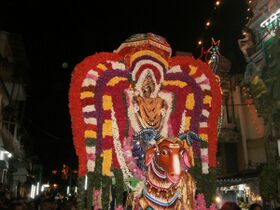Astronomy:Surasamharam
| Surasamharam | |
|---|---|
 Festival image of Murugan during a procession | |
| Also called | Kanda Shashti |
| Observed by | Tamil Hindus |
| Type | Hindu |
| Significance | Victory of Murugan over the asuras |
| Date | Template:Hindu festival date Aippasi or Kartikai month of the Tamil calendar |
| 2023 date | 18 November (Saturday) |
| 2024 date | 7 November (Thursday) |
| Frequency | Annual |
Surasamharam (Tamil: சூரசம்ஹாரம், romanized: Sūrasaṃhāram),[1][2] also called Suranporu, is a Hindu ritual folk performance that recreates the legend of the killing of asuras by the deity Murugan. It is the culmination of the week-long Kanda Shasthi Vratam festival.[3] It is performed mainly in Tamil Nadu. It is also celebrated in Andhra Pradesh, Sri Lanka, and the district of Palakkad in Kerala at temples dedicated to Murugan. This festival falls in the month of either Aippasi or Kartikai of the Tamil calendar.[4]
Description
The Surasamharam performance is based on the legend of Murugan, also known as Kanda, as described in the Kanda Purana. In the days preceding the performance, the Kanda Purana is narrated in the temple. The performance ends with the killing of Surapadman and his allies, which is depicted through the symbolic beheading of the four asuras of Anamugan, Panumugan, Simhamugan, and Surapadman by Murugan, employing his divine spear, known as the vel.[3] For the performance the vel is specially consecrated; during the staging of the show, it is ceremonially placed on the neck of the effigy, after which the head is removed, depicting the beheading of the asura.[3]
Surasamharam is preceded by several ceremonies on the last day of the Kanda Shashti festival. Special pujas are conducted and the deity of Murugan is ritually anointed in the ritual of abhishekam. Devotees are offered an auspicious sight of the deity, called a darshana. In some parts of Tamil Nadu, devotees observe a six-day fast, which they break at the end of the Surasamharam. In Palani, a procession of Murugan (locally called the Dandayuddhapani) is taken down from the Palani Murugan Temple and led through the main thoroughfares of the town before the Surasamharam.[5]
At the Tiruchendur Murugan Temple, six days of celebrations for Kanda Shashti start from the tithi of the Aippasi month, culminate on the day of Surasamharam. The performance of the tiru kalyanam, the ceremonial wedding ceremony of the deity and his consorts, is observed on the day following the Surasamharam.[4]
In Tamil Nadu, the Surasamharam is witnessed every year by large crowds of devotees. The state government and Indian Railways ply special buses and trains to facilitate their travel.[6] In Kerala's Palakkad district, Surasamharam, is held in all the major Tamil settlements in the district.
References
- ↑ Aruljothi, C.; Ramaswamy, S. (2019-06-07) (in en). Pilgrimage Tourism: Socio-economic analysis. MJP Publisher. pp. 170. https://books.google.com/books?id=cdCbDwAAQBAJ&pg=PA170.
- ↑ J.K. BANTHIA (1995). Temples of Tamil Nadu Kancheepuram District. pp. 125. http://archive.org/details/temples-of-tamil-nadu-kancheepuram-district.
- ↑ Jump up to: 3.0 3.1 3.2 "The fall of demons". The Hindu. 27 December 2012. http://www.thehindu.com/arts/theatre/the-fall-of-demons/article4244670.ece. Retrieved 24 January 2013.
- ↑ Jump up to: 4.0 4.1 "2021 Skanda Sashti, Kanda Sashti dates for New Delhi, NCT, India". https://www.drikpanchang.com/vrats/skanda-sashti-dates.html?year=2021.
- ↑ "Dhandapani Murugan Kovil". Tamilnadu.com. 5 March 2013. Archived from the original on 7 March 2013. https://web.archive.org/web/20130307142728/http://tamilnadu.com/temples/dhandapani-murugan-kovil.html.
- ↑ "Thousands of devotees witness Soorasamharam". The Hindu. 19 November 2012. http://www.thehindu.com/todays-paper/tp-national/tp-tamilnadu/thousands-of-devotees-witness-soorasamharam/article4110166.ece. Retrieved 24 January 2013.
External links
http://www.tiruchendurmurugantemple.tnhrce.in/festival.html
 |


